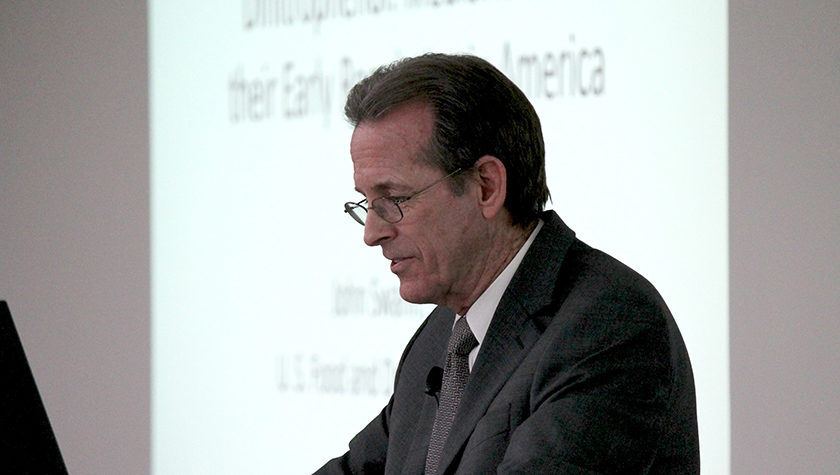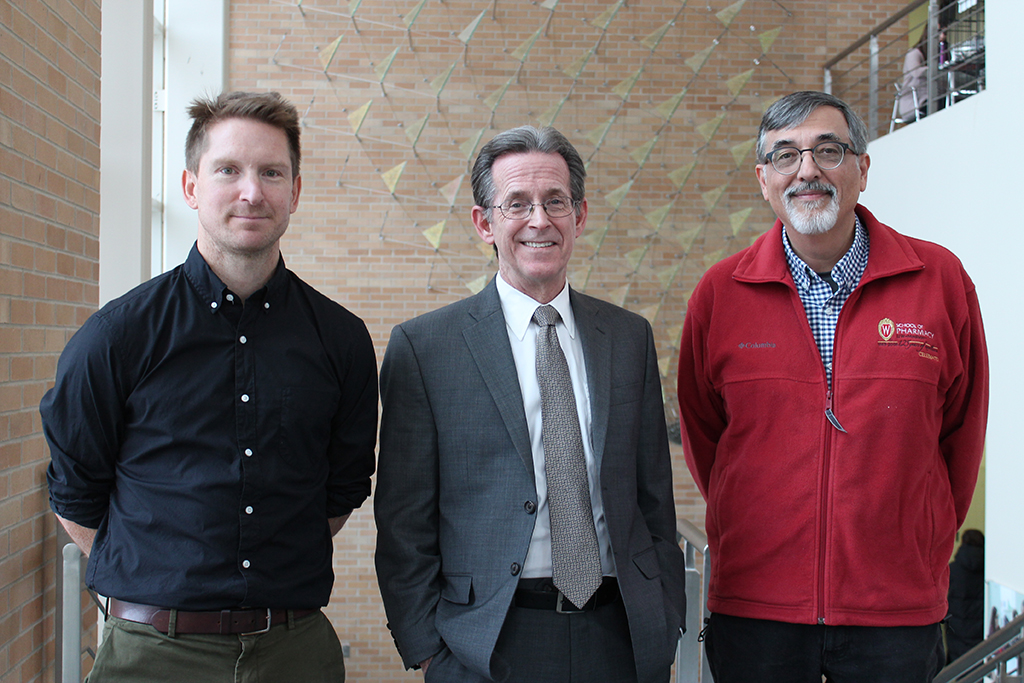
5
December

School of Pharmacy degree takes John Swann to a career as FDA historian
By Katie Ginder-Vogel
A few years after he joined the U.S. Food and Drug Administration (FDA) as historian, John Swann (MS ’82, PhD ’85) received a phone call that would stick with him for decades. On the other end of the line was a woman from Oregon whose mother had recently died as a result of taking rainbow diet pills.
The woman and her brother were looking for information on the Congressional investigation of the drugs and found their way to the FDA History office. Swann helped them find the transcripts of the 1968 Senate hearings and began his own investigation into the history of the pills, which traces back to the 1940s. That research, he says, developed into a lifelong obsession.
“Rainbow diet pills were manufactured by a small group of companies in the 1940s, and they were a fixed combination of potent drugs, including desiccated thyroid, digitalis, an amphetamine plus a barbiturate, and a thiazide diuretic pills,” says Swann. “The Oregon state coroner reported on several deaths he linked to rainbow pills in the 1960s, and it’s likely the callers’ mother was among them.”
Swann has published several articles on diet pills, one of which covered the rainbow pills of decades ago and a modern version, and he says he is considering making the story of the pills into his second book.
“That’s the great thing about talking to people — you have the opportunity to help them and you learn so much,” he says.
At the FDA, Swann — a graduate of the University of Wisconsin–Madison School of Pharmacy with a master’s and PhD degree in the history of pharmacy and history of science — enjoys his role as a public historian and the opportunities he has to work with large groups of people. He appreciates his day-to-day variety of projects and responsibilities, such as presenting the history of the FDA to new employees and curating exhibits, such as the new “Our History: The Food and Drug Administration” exhibit on FDA campus in White Oak, Maryland, open to students, researchers, and citizens.
“History is about sharing, storytelling, educating, and learning,” says Swann. “We get to do all that, plus exhibits, which offer a great way to think about history in three-dimensional terms.”
The path to history
Swann, who grew up in Leavenworth, Kansas, first came to the UW–Madison School of Pharmacy — the first U. S. school to offer a doctoral degree in the history of pharmacy — at an unusual time. Firstly, it was the middle of winter. Secondly, it was the middle of the academic year.
But after being referred to the program by one of his professors in the history of science at the University of Kansas, Swann realized he didn’t have time to spare.

“Aaron Ihde, a historian of chemistry whose textbook was used in our undergraduate classes at KU, was planning to retire at the end of the year, and I wanted to take a class from him before he retired,” says Swann. “It was a little challenging because people identify with their incoming classes, and I didn’t really have that experience because no one really came in mid-year.”
Swann loaded all his worldly possessions into his VW Squareback, which had a broken heater.
“My feet were so cold!” says Swann. “I got into Madison right after a snowstorm had come through, and I couldn’t get around or see the street signs because of the snow. I parked the car to go look for rental housing, and the battery died. And of course the VW Squareback battery is in the back, so I had to unload all my stuff in the snow to jumpstart the car.”
Despite his inauspicious arrival, Swann took a seminar with Ihde, alongside Ihde’s last two graduate students, Sheldon Hochheiser and Christopher Hamlin.
“Despite my intimidation at being a brand-new student in a seminar with two experienced grad students, Chris and Shelly were incredibly welcoming, and Dr. Ihde was one of the finest people I’ve met in my life,” he says.
Another of his student colleagues was Greg Higby (MS ’80, PhD ’84), who went on to serve as executive director of the American Institute on the History of Pharmacy, housed within the School of Pharmacy, for three decades and is currently senior academic curator and a senior lecturer at the School.
“I still run across incredible stories in our collection. I’m still encountering surprises after 30 years.”
—John Swann
At the advice of his professors in the School of Pharmacy, Swann earned his master’s in Pharmacy and his PhD in both Pharmacy and History of Science.
“Having a foot in both fields really did help my career in the long run,” says Swann. “It’s important that students be flexible about what they do when they finish,” he says.
Swann began his graduate work with Glenn Sonnedecker, who team-taught one of Swann’s favorite courses, Pharmacy 410/History of Science 410, on the evolution of food and drug controls from the 18th century until the present. Ihde taught the food portion, and Sonnedecker and John Parascandola handled the drug history.
Swann describes the very last session of the course, a mock panel, in which the professors acted out a skit about a food company executive, an FDA commissioner, and a consumer advocate debating each other, as particularly memorable and entertaining.
“Aaron played a food company executive, which was so against type,” says Swann. “Glenn was perfectly cast as an FDA commissioner, and Shelly Hochheiser filled in for John playing a consumer advocate. They’d taunt and bait each other; it was a lot of fun. When I took that class, I had no idea I’d spend the rest of my career as an FDA historian.”
Becoming an FDA historian
Between graduating from the School and finding his way to the FDA, Swann completed a year-long postdoc at the Smithsonian National Museum of American History.
“Networking is so important,” says Swann. “The Smithsonian’s head of the division of medicine and science, Ramunas Kondratas, knew the UW–Madison faculty members I’d been working with really well, and that helped me out.”
Swann describes his postdoc at the Smithsonian as “a fascinating time.”
“I met the most interesting fellows who did fantastic projects,” he says. “People were working on the history of air conditioning, gypsies in America, the history of the Federal Reserve, and railroads. Because I had studied the history of antibiotics in graduate school, I was permitted to help with a related exhibit set up at the Cooper Hewitt Design Museum.”

Swann also took the time to revise his PhD dissertation into a book, Academic Scientists and the Pharmaceutical Industry: Cooperative Research in 20th-Century America.
Swann’s next position was at the University of Texas Medical Branch, the oldest public medical school in Texas, in 1989. Project director Chester Burns was writing a detailed history of the school for its centennial celebration and hired Swann to conduct research on networks of research at the school.
After that project, Swann learned that the FDA was interested in hiring a historian with knowledge of the history of drugs to complement the historian of food regulation, Suzanne White. Swann was hired in December 1989 and has spent the past 30 years at the FDA.
“Suzanne did food regulation history, I did drug regulation history, and we split everything else,” says Swann. “I hadn’t studied the history of drug regulation beyond my classes in graduate school, but it’s a complicated subject that I enjoy, and I’ve been learning about it ever since.”
He recently returned to the School as a guest speaker in the UW–Madison Go Big Read event series. This year’s selection was Deborah Blum’s The Poison Squad, which tells the story of how Harvey Wiley, the first head of the FDA, led a herculean effort to make food and medications safer in the U.S.
But in his presentation, he instead focused on the problems with drugs in the 19th and early 20th centuries and the evolution of federal regulation.
“It’s a story that doesn’t have a Harvey Wiley-style hero front and center, but it certainly makes up for it with all the scoundrels who hoisted adulterated, misbranded, worthless, and deadly remedies upon an innocent public,” says Swann, alluding to the dozens of concoctions peddled as miracle cures for everything from diabetes to “female troubles.”
“In the 19th century, pharmaceutical regulation was voluntary, and pharmacists and physicians felt it was important to do something about the products in the drug supply,” he says.
Swann also addressed the important role of the press, including journalists Samuel Hopkins Adams, who wrote about public health and patent medicines; and Edward Bok, who wrote about the abuses of drugs. He also talked about the impact of the Pure Food and Drugs Act of 1906 and the passage of the 1938 Food, Drug, and Cosmetic Act, under which the FDA still operates today, though it has been amended more than a hundred times.
“In the 19th century, pharmaceutical regulation was voluntary, and pharmacists and physicians felt it was important to do something about the products in the drug supply.”
—John Swann
Those amendments responded to such crucial public health needs as certified insulin, the differentiation between drugs that could be used for self-medication and those requiring a prescription, a mandate for effective drugs, premarket approval of medical devices, the incentivizing of treatments for rare diseases, expedited approval of generic drugs, user fees to accelerate the evaluation of medicines, and drug quality and security, says Swann.
“Millions with rare conditions have benefited from the orphan drugs developed after incentives were put in place, and generic drugs have made drugs affordable for countless patients, so those many amendments of the Federal Food, Drug, and Cosmetic Act of 1938 have resulted in positive progress toward greater drug safety and reliability,” he says.
Swann met Blum when the FDA hosted her for a talk in September and had the opportunity to show her the Poison Squad notebooks, which she had never seen before. The notebooks include the original, raw data recorded by a group of volunteers, dubbed the Poison Squad, who worked with Wiley to essentially poison themselves with preservatives already available on shelves to show how important it was to regulate food.
“The notebooks contain the names of the almost three dozen volunteers, raw data from the examinations of the waste products of the Poison Squad members, and their reactions — what they were able to say about their experiences taking these different preservatives,” says Swann. “Bulletin 84, the published version, is the one people rely on, and you can see everything this was drawn from and recorded, probably written in Harvey Wiley’s hand.”
Swann says conversations from investigators like Blum and the woman hoping to learn more about the pills that led to her mother’s death keep his job his consistently interesting as he sorts through more and more of the FDA’s history.
“I still run across incredible stories in our collection,” Swann adds. “I’m still encountering surprises after 30 years.”




